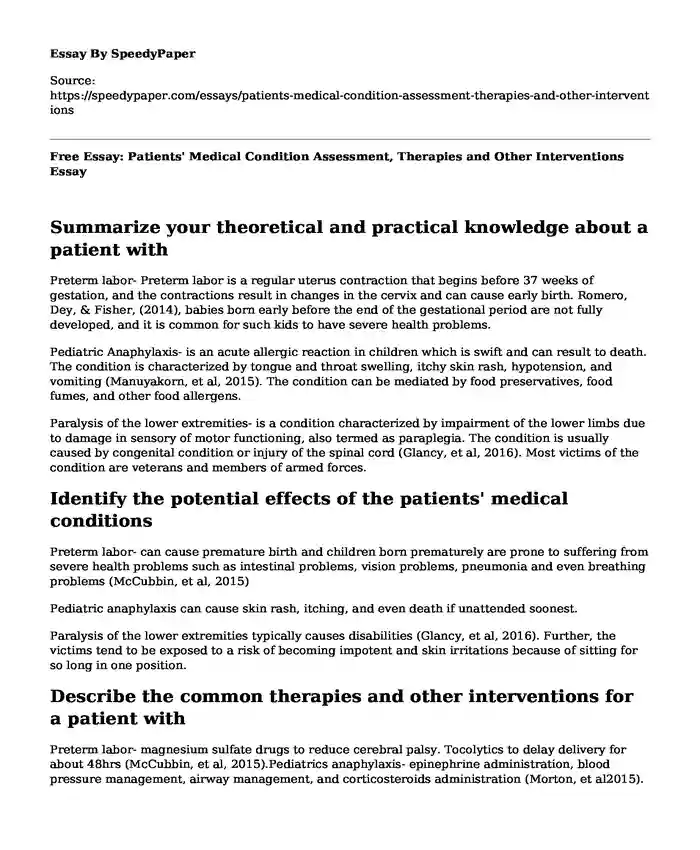Summarize your theoretical and practical knowledge about a patient with
Preterm labor- Preterm labor is a regular uterus contraction that begins before 37 weeks of gestation, and the contractions result in changes in the cervix and can cause early birth. Romero, Dey, & Fisher, (2014), babies born early before the end of the gestational period are not fully developed, and it is common for such kids to have severe health problems.
Pediatric Anaphylaxis- is an acute allergic reaction in children which is swift and can result to death. The condition is characterized by tongue and throat swelling, itchy skin rash, hypotension, and vomiting (Manuyakorn, et al, 2015). The condition can be mediated by food preservatives, food fumes, and other food allergens.
Paralysis of the lower extremities- is a condition characterized by impairment of the lower limbs due to damage in sensory of motor functioning, also termed as paraplegia. The condition is usually caused by congenital condition or injury of the spinal cord (Glancy, et al, 2016). Most victims of the condition are veterans and members of armed forces.
Identify the potential effects of the patients' medical conditions
Preterm labor- can cause premature birth and children born prematurely are prone to suffering from severe health problems such as intestinal problems, vision problems, pneumonia and even breathing problems (McCubbin, et al, 2015)
Pediatric anaphylaxis can cause skin rash, itching, and even death if unattended soonest.
Paralysis of the lower extremities typically causes disabilities (Glancy, et al, 2016). Further, the victims tend to be exposed to a risk of becoming impotent and skin irritations because of sitting for so long in one position.
Describe the common therapies and other interventions for a patient with
Preterm labor- magnesium sulfate drugs to reduce cerebral palsy. Tocolytics to delay delivery for about 48hrs (McCubbin, et al, 2015).Pediatrics anaphylaxis- epinephrine administration, blood pressure management, airway management, and corticosteroids administration (Morton, et al2015).
Paralysis of the lower limbs- physiotherapy interventions to rehabilitate the patients (Glancy, et al, 2016)
Discuss the effects of the following medications on a patient with:
Preterm labor- Nefidipine- fast heart rate, dizziness, nausea, muscle cramps, and constipation.
Preterm labor- Betamethasone- insomnia, increased sweating, nausea and slow wound healing
Pediatric anaphylaxis- Epinephrine- breath shortness, swelling of the throat, peeling of the skin without fever, rash and wheezing
Diphenhydramine- a headache, blurred vision, irritability, dizziness and drowsiness
Methylprednisolone- insomnia, headache, nausea, and acne
Ranitidine- a headache, nausea, dizziness, and constipation
What data (including lab and diagnostic studies) do you need to know about the patients before beginning your assessment?
Morton, et al, (2015), before assessing any patient, it is vital to interact with the patient and to understand them. First, knowing a patient's cultural beliefs if necessary. Second, knowing if the patient had used any drug before attending the healthcare facility can help in the assessment process. Noting the patient's age is also vital as it will help to determine the kind of interventions and care plans for the patient.
Considering what you know about a patient with preterm labor, pediatric anaphylaxis response, and paralysis of lower extremities, what will you make sure to notice when you go into the patient room?
It is important to note the severity of the condition. For example, preterm labor patient should be attended soonest to save the child and the mother as prolonged preterm labor may result in the death of both the mother and kid. Besides, it is essential to learn the facial expression of the patient is critical as it will help to estimate the degree of pain experienced by the patient (Morton, et al2015). Noticing the mobility of the patient is essential.
References
Glancy, D. L., Subramaniam, P. N., & Rodriguez, J. F. (2016). Lower Extremity Paralysis. American Journal of Cardiology, 118(10), 1609-1610.
Manuyakorn, W., Benjaponpitak, S., Kamchaisatian, W., Vilaiyuk, S., Sasisakulporn, C., & Jotikasthira, W. (2015). Pediatric anaphylaxis: triggers, clinical features, and treatment in a tertiary-care hospital. Asian Pac J Allergy Immunol, 33(4), 281-8.
McCubbin, K., Moore, S., MacDonald, R., & Vaillancourt, C. (2015). Medical transfer of patients in preterm labor: treatments and tocolytics. Prehospital Emergency Care, 19(1), 103-109.
Morton, P. G., Fontaine, D., Hudak, C. M., & Gallo, B. M. (2017). Critical care nursing: a holistic approach (p. 1056). Lippincott Williams & Wilkins.
Cite this page
Free Essay: Patients' Medical Condition Assessment, Therapies and Other Interventions. (2022, Mar 02). Retrieved from https://speedypaper.net/essays/patients-medical-condition-assessment-therapies-and-other-interventions
Request Removal
If you are the original author of this essay and no longer wish to have it published on the SpeedyPaper website, please click below to request its removal:
- Free Essay with an Article Review Example
- Post Laboratory Questions - Chemistry Essay Example
- Religion Essay Sample: Islam in Africa
- Hypnosis and Meditation - Essay Example for Students in Need
- Essay Sample: An Economic Evaluation of Vaccination Programs
- Problem 10.2
- The Indictment of the Auschwitz Guard, Law Essay Sample
Popular categories





